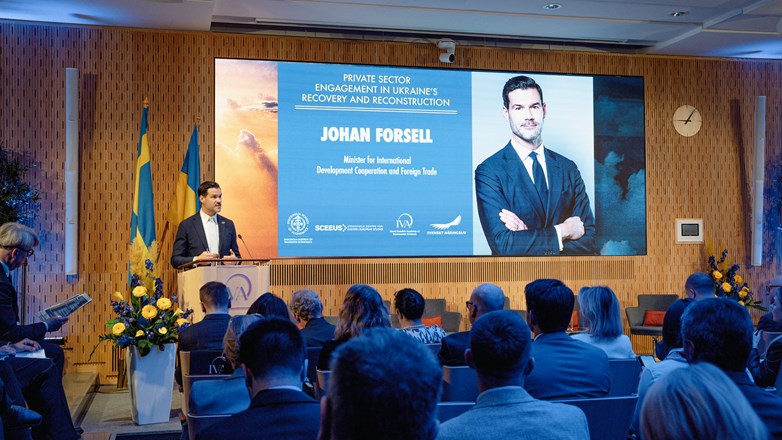Key takeaways from the conference "Private sector engagement in Ukraine’s recovery and reconstruction"
Background
Ukraine presents a compelling investment opportunity due to its vast growth potential and the enormous needs of reconstruction in the years ahead. While various figures have been cited in different contexts, an estimate mentioned here suggests that the cost for the recovery of the directly damaged infrastructure amounts to $411 billion USD (with the KSE Institute estimating damaged real estate and infrastructure at approximately $144 billion USD at replacement cost). While this is below 1% of the collective GDP of G7 countries, and therefore fully affordable, it is not desirable that public money should finance it in its entirety. On the other hand, it is crucial to disaggregate these figures based on different types of investments. Distinguishing between private and public investments becomes essential when considering the source of funding, required magnitudes, and future ownership considerations. It is important to underscore that reconstruction and recovery implies building back a better, more sustainable Ukraine geared towards becoming a full EU member.
The conference in Stockholm on furthering the private sector engagement in Ukraine’s recovery and reconstruction assembled senior technical level officials and representatives from: national ministries and agencies, business organizations, the private sector, and expert communities, of Ukraine, EU MS, leading G7-countries, the EU -institutions; and IFIs/DFIs. Three panels were held on “Rebuilding and transforming Ukraine: investment climate, governance and EU integration”, ”Preconditions for resource mobilization: the public-private connection”, and “Risk mitigation tools: pushing the agenda forward”.
Main takeaways from the conference
- Reconstruction is not a consequence of victory but an already ongoing process that leads to victory. The challenge is in the present, not in the distant future. The business community has very ambitious plans and goals for next month, not next decade. The main challenge is the security situation at both project and country levels. The former requires risk management instruments, on which progress is being made; the latter clear security guarantees, best addressed by a clear pathway to NATO membership.
- Governance concerns, including corruption as well as corruption perceptions, should be addressed swiftly by implementing EU accession requirements. The existence of corruption should be acknowledged, but it does not overshadow Ukraine's prospects for investment. The EU should view Ukraine as a solution, not a problem, and recognize its assets -- talents, raw material including rare earth minerals, agricultural products, a large market, not least its incredible resilience -- and potential for wealth generation. Many sectors are growing despite the ongoing conflict.
- It should be kept in mind that risks are perceived on both sides. Building partnerships and trust between investors and Ukrainian businesses is crucial due to past negative outcomes.
- Extraordinary operational resilience partly offsets security and transparency risks, with examples of facilities recovering quickly and recording profitability. Two outstanding examples: Poland’s trade insurance and trade finance agency reported a default rate of approximately 1% following last February’s invasion, lower than that experienced as a consequence of Brexit; a very large steel plant affected by the current flooding expected to resume operations within days and has recorded profitability in 2023 despite the destruction of many facilities.
- Predictability and progress on key policy factors would reduce risk and burden on donor countries for providing concessional de-risking capital. The European process serves as an anchor for Ukraine's transformation and is the best guarantee for investors worldwide. There is a need for clarity on the timeline for EU accession, NATO accession, and the scope and timeline of reforms that Ukraine is expected to implement.
- Prerequisites for investment include a functioning banking, financial, and insurance sector. Banking sector and communications in Ukraine still work reliably, and tolerance for corruption is lower due to the war. Priority in the short term should be given to export credit guarantees and insurance solutions. Crucially, different types of insurance are needed, new tools should be tailored to this situation. The existing tools should be packaged together as a coherent offer to investors. This should be led by the official sector, to enable local lenders and mitigate market failures. A centralized reinsurance structure is currently under development. It will need risk-absorbing donor capital from G7 countries. It is expected to be launched at the London conference.
- Enhancing foreign direct investment and capacity for absorption is crucial, both were lacking even prior to the full-scale invasion. Good procurement procedures, along with decentralization and local autonomy, are notable strengths. The provision of technical assistance and advisory services can further support these efforts. A clear finance-ready pipeline of projects should be established to attract investors. This is best accomplished by instituting a permanent executive at a senior level, to coordinate efforts and ensure effective progress in-between the high-level international meetings.
- IFIs have spare capacity but need concessional capital to mobilize more funding. Early transaction successes can then gradually draw in more private investors. Significant leverage is possible. For example, IFC can deploy €6 for every €1 of donor capital.
- Support for seizing Russian assets to pay for war damages is generally strong.
Still open issues
- The relative share of funding and responsibility of public and private sector was not addressed explicitly. The private sector assumes that there will be plenty of public funds available in the reconstruction process, while the public sector stresses the importance of private capital to fund the reconstruction needs. This lack of clarity also creates at this stage a sense of competition for funding between the public and private sector within Ukraine, which is hurting the process.
- Coordination between international donors and the Ukrainian government is still complicated. There is overall consensus on Ukrainian “ownership” of the process but somewhat different emphasis on need for external supervision/co-ownership in projects. The IFIs do not see the need for a separate Ukraine reconstruction agency and argue it will take too long to set up and get going. Others argue that the process must have a clearer leadership and governance structure with one high-level person leading an institution with a clear, single mandate to coordinate reconstruction assistance. The Multi agency donor coordination platform is seen as a step in the direction of better coordination, but falls short of a strong leadership backed by a significant staff that works on the issues every day, and not only through meetings that are months apart.
- Ownership after reconstruction. There was not so much discussion about who will own key assets in Ukraine after the war and reconstruction. Clearly the private sector will not spend its money in the reconstruction process without ownership at the end. Even if corporate or infrastructure bonds could be an alternative, this is clearly complicated issue since pre-war ownership has to be taken into account when cities and infrastructure that were destroyed in the war are rebuilt.
-
Balance sheets after reconstruction. If Ukrainian entities (central and local governments, public companies and utilities, private businesses, households) borrow to rebuild, their balance sheets will be weakened, and the issue of debt sustainability will need to be addressed sooner or later. If foreign businesses instead rebuild with their own funds, ownership will need to be granted. If IFIs finance reconstruction, it will be concessional debt in many cases, which still is debt. Only grants from foreign governments, multilaterals, and philanthropists in combination with reparations from Russia can restore damaged properties without impairing Ukrainian balance sheets.
Program, meet the speakers and input papers
See the full program from the 8 June event, read about the speakers & delve deep into the input papers written by prominent experts.
Photo: Dominick Nilsson




